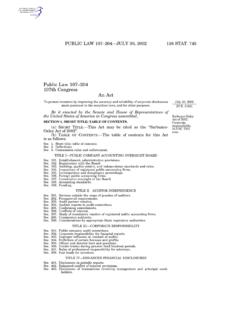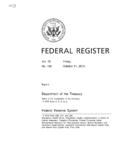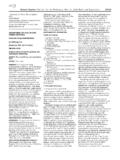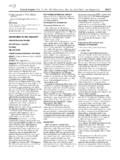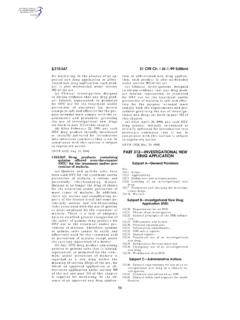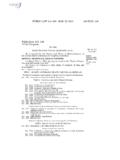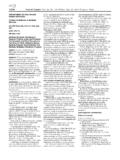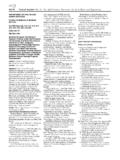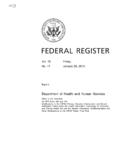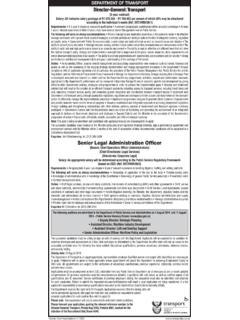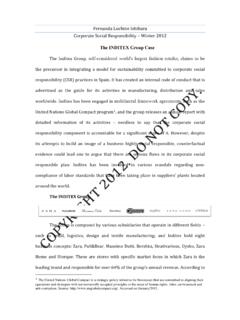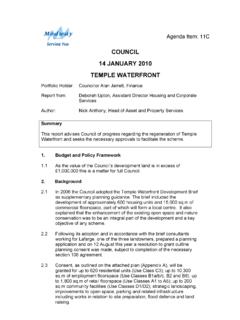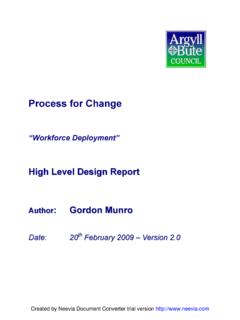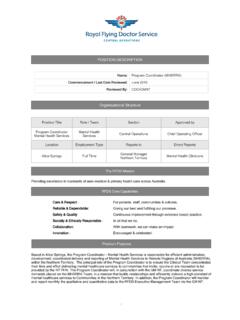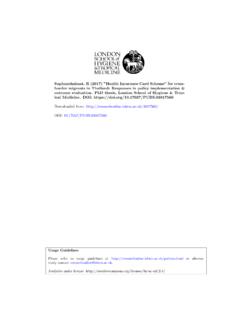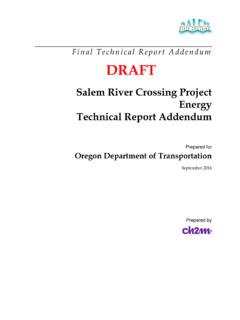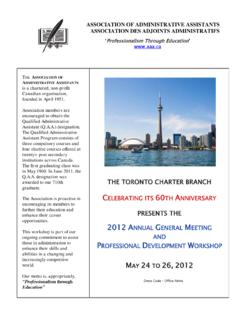Transcription of DAVE HODGE, BEN LANNING, - gpo.gov
1 Memorandum Decision and Order 1 IN THE UNITED STATES DISTRICT COURTFOR THE DISTRICT OF IDAHODAVE HODGE, BEN LANNING, Plaintiffs,-vs-LEAR SIEGLER SERVICES, INC., aDelaware Corporation, Defendant.))))))))))))CASE NO. CV 06-263-MHWMEMORANDUM DECISIONAND ORDER Currently pending before the Court for its consideration is Plaintiffs Motion to CertifyClass Action (Docket No. 23), filed August 30, 2007. The Court heard oral argument onNovember 6, 2007, and has had an opportunity to review the briefing submitted as well as otherpertinent documents in the Court s file. The Court finds that Plaintiffs Motion should begranted for the reasons discussed in this opinion. July 7, 2006, Plaintiff dave hodge filed a Complaint against his former employer,Defendant Lear Siegler Services, Inc. ( LSI ), for breach of his employment contract. He lateramended his complaint to add Mr.
2 ben lanning as a plaintiff and class representative. DocketCase 1:06-cv-00263-MHW Document 43 Filed 12/07/07 Page 1 of 15 Memorandum Decision and Order 2 No. 20. Plaintiffs claim that LSI breached their employment contract by failing to pay them andother employees stationed in Iraq for all hours worked. The employment agreement, whichPlaintiffs assert was the same for all hourly workers with regard to reimbursement policies,required payment at a base hourly wage for all hours worked over 40 hours per week. However, Plaintiffs allege that they and other employees were not paid to drive their fellowemployees to job sites and for time spent traveling to their work sites, or for off the clock andovertime work in addition to their standard work week. Plaintiffs allege that there are over 2,000similarly situated employees and seek class Standards Governing Class Certification Under Rule 23(a).
3 The burden is upon the plaintiff to establish whether a proposed class satisfies Rule 23 ofthe Federal Rules of Civil Procedure. Bafus v. Aspen Realty, Inc., 236 652, 655 (D. Idaho2006). In order to certify a class, the plaintiff must first meet the four threshold requirements ofRule 23(a) namely: (1) numerosity, (2) commonality, (3) typicality, and (4) adequacy ofrepresentation. Hanlon v. Chrysler Corp., 150 1011, 1019 (9th Cir. 1998). Fed. R. Civ. P. 23(a) states:One or more members of a class may sue or be sued asrepresentative parties on behalf of all only if (1) the class is sonumerous that joinder of all members is impracticable, (2) thereare questions of law or fact common to the class, (3) the claims ordefenses of the representative parties are typical of the claims ordefenses of the class, and (4) the representative parties will fairlyand adequately protect the interests of the class.
4 Case 1:06-cv-00263-MHW Document 43 Filed 12/07/07 Page 2 of 15 Memorandum Decision and Order 3 After satisfying these four requirements, a plaintiff then must demonstrate under Rule 23(b)(1),(2), or (3) that the action is maintainable. Hanlon, 150 at 1022. Classes may be certified only if the Court is satisfied, after a rigorous analysis, that theprerequisites of Rule 23(a) and (b) have been satisfied. Bafus, 236 at 655 (citingChamberlan v. Ford Motor Co., 402 952, 961 (9th Cir. 2005)). An extensive evidentiaryshowing by the plaintiff is not required and the court is bound to use some degree of speculation;however, there must exist before the court sufficient material to determine compliance with therequirements of Rule 23. Blackie v. Barrack, 524 891, 901 (9th Cir. 1975). While theCourt is required to take the substantive allegations of the Complaint as true, the Court maydisregard allegations that are merely conclusory, are not substantive or are facially insufficient.
5 Lim v. Citizens Sav. & Loan Assoc., 430 F. Supp. 802, 808 ( Cal. 1976). In this case, thePlaintiffs have met their burden at this stage to have the Court conditionally certify a class. TheCourt will examine each requirement under Rule 23(a). first requirement under Rule 23(a)(1) is that the class [be] so numerous that joinderof all members is impracticable. While an exact number is not required, Plaintiffs mustsufficiently identify the existence of a number of persons to be included in the proposed class. Schwartz v. Upper Deck Co., 183 672, 680 ( Cal. 1999). Plaintiffs may not merelyspeculate but must provide a reasonable estimate of the number of class members. Schwartz,183 at 681; Nguyen v. Kissinger, 70 440, 445 (D. Or. 1983). A higher level ofproof than mere common sense impression or extrapolation from cursory allegations isrequired.
6 Schwartz, 183 at 1:06-cv-00263-MHW Document 43 Filed 12/07/07 Page 3 of 15 Memorandum Decision and Order 4 In this case, Plaintiffs rely upon the testimony of Phillip Wagstaff, LSI s designee, whotestified as to LSI s employment policies. According to Mr. Wagstaff, LSI employed 3,158people in Iraq between March 2004 and June 2007. Eighty-five percent, or 2,684, of thoseindividuals were hourly workers employed as mechanics, warehouse workers, working foremenand supervisors. These employees were deployed under a government subcontract agreement toprovide support to United States military operations in Iraq. All of the workers had signed anemployment agreement with LSI containing the same provision guaranteeing payment at theagreed upon hourly wage for all hours worked. Wagstaff Depo. at 14, 52 53; Brown Depo.
7 At16. Plaintiffs contend that the class includes all hourly workers employed by LSI for theprevious five years. The Court finds that based upon the number of employees, and the relative certainty thatnumber can be determined, the proposed class in this case exceeds the minimum required to raisethe presumption that joinder is impracticable. Defendant does not dispute this have therefore fulfilled the numerosity requirement in this case. next step in Rule 23(a)(2) requires that there are questions of law or fact common tothe class. Commonality is met when substantial questions of law or fact common to the classexist. Schwartz v. Upper Deck Co., 183 672, 682 ( Cal. 1999). Not all questions,however, need be common to the class, and the presence of one significant issue common to theclass may be sufficient to warrant certification.
8 Dukes v. Wal-Mart, Inc., 474 1214, 1225(9th Cir. 2007). In examining this requirement a court should focus on the defendant s conduct. Schwartz, 183 at 683. [I]llegal standardized conduct by the defendant should beCase 1:06-cv-00263-MHW Document 43 Filed 12/07/07 Page 4 of 15 Memorandum Decision and Order 5 identified. Schwartz, 183 at 683 (internal quotations omitted). If a plaintiff can establishthat company wide policies exist common to the class, this element may be satisfied. Dukes, at 1225 (explaining that the plaintiff demonstrated corporate practices existed common tothe class). This requirement will not be defeated by slight differences between class members. Schwartz, 183 at 682 Defendant argues that Plaintiffs claims are unique to them, there are sufficientquestions of fact and law common to the class to fulfill the commonality requirement.
9 Plaintiffsallege that all hourly workers were required to enter into a standardized contract containingidentical compensation provisions, albeit with different base hourly wage rates. Plaintiffs alsocontend that Defendant employed the same employment policies at each of its work sites in Iraq. It is these employment policies that Plaintiffs focus on, and which establish are three employment policies at issue common to the class. The first policy was acumbersome process to get advance approval for overtime work. This policy required forty-eight hours advanced notice to work overtime, despite what Plaintiffs contend were suddenemergencies that arose in the repair shops where vehicles had to be repaired for their immediatereturn to the military, often the next day for convoy or operational purposes. Plaintiffs contendthat the policy was enforced company-wide in part by prohibiting or discouraging employees torecord anything over twelve hours per day on their time sheets despite the fact that they wouldwork more than twelve hours on that particular day.
10 Plaintiff Hodge was told by his supervisorto write down twelve hours and no more, even if he actually worked longer that day. PlaintiffLanning was also told to write down twelve hours because that was the amount of timeDefendant was authorized to bill for his work, regardless of how long he actually worked. Case 1:06-cv-00263-MHW Document 43 Filed 12/07/07 Page 5 of 15 Memorandum Decision and Order 6 Plaintiff Hodge alleged that after the fact approval for overtime work was denied. Hodge 10. The second and third policies concern commuting. Plaintiffs allege that LSI failed to payemployees for driving vans full of other employees to work sites. Plaintiffs contend that LSIrequested volunteer drivers to drive employees to their job sites if the job site was greater thanwalking distance, and that only after an accident did LSI require drivers to be paid.
